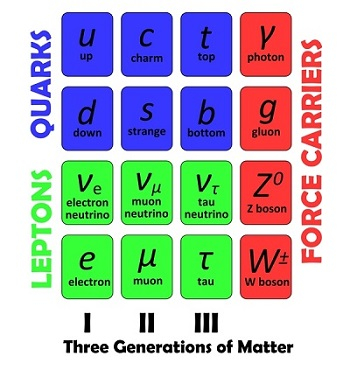Introduction
In the history of physics, the composition of matter was always a central question. The question “What is the universe made of?” is baffling scientists since ancient times. At the beginning of the 20th century, several experiments were carried out by the physicists like Thomson, Rutherford, etc.
They found that an atom is made is not indivisible, and it is made of smaller particles. Slowly, it became clear that the atom consists of electrons, protons, and neutrons. Protons and neutrons reside in the nucleus and the electrons revolve around it. In the 1930s, many physicists thought that the problem of the fundamental structure of matter is solved. But as years progressed, technological advancements increased the accuracy and capacity of the labs. Physicists started using particle accelerators to bang particles to each other with higher and higher energies.

In this process, many new particles got discovered. Muon, Kaon, Pion, etc are such examples. They were so many that it became difficult to keep track of them. Hence physicists introduced a scheme to categorize these particles. It is called the “Standard Model” in physics.
What is Lepton?
Elementary particles can be categorized in many ways. One way could be to categorize them in terms of their spin. All the particles with half-odd integer spin eg. – 1/2, 3/2,5/2, etc. are called fermions. Particles with an integer value of spin, eg. – 0,1,2, etc. are called bosons. One more classification can be based on the masses of the particles. Light mass particles are called leptons, medium mass particles are known as Mesons and heavy particles are called baryons.
Lepton is light mass particles with half-integer spins. Leptons can be charged or neutral. Electrically charged leptons are called electron-like lepton, and neutral leptons are called neutrinos.
Explore our latest online courses and learn new skills at your own pace. Enroll and become a certified expert to boost your career.
Anti-Lepton
In particle physics, each particle has a corresponding antiparticle. Particles and antiparticles have the same mass but they differ in charge. They have opposite charges. When particles and antiparticles interact, they annihilate each other and produce photons. Anti-lepton is an antiparticle of lepton.
We can the example of the antilepton in the following process- A W+ Boson decays and gives positron and neutrino. We know the electron is a neutrino, here the position is the antiparticle of the electron. Hence it is an antilepton.
History of Lepton
The first lepton to be discovered was the electron. In 1897, British physicist J.J. Thomson discovered it. Subsequently, in 1936, Muon was discovered by Carl Anderson. In 1930, Wolfgang Pauli proposed that for the conservation of energy and momentum, in beta decay, there should be a particle. Later this particle was identified as electron neutrino or neutrino.
In 1940, A new category of particle was introduced and they were called “Leptons”. In 1962, three physicists Lederman, Schwartz, and Steinberger showed that there are not only types of neutrinos but many. It led to the Nobel prize in physics in 1988. In 1975, Martin Perl discovered a new category of lepton, tau lepton. For this, he shared the Nobel prize in 1995.
In 2000, the Fermi lab detected the first-ever tau neutrino interaction. These days some physicists are in search of the fourth generation of leptons.
Types of Lepton
So far we know about six types of leptons which comes in three families. Each one of which possesses an antiparticle. Types of leptons summarised below
| Family | Particle | Symbol | Antiparticle | Charge | Mass(Me V/C22) | Lepton Number |
|---|---|---|---|---|---|---|
| Electron | Electron | e−e− | e+e+ | -1 | 0.511 | 1 |
| Electron neutrino | veve | v−eve− | 0 | 10−710−7 | -1 | |
| Muon | Muon | μ−μ− | μ+μ+ | -1 | 105.7 | 1 |
| Muon neutrino | vμvμ | v−μvμ− | 0 | 10−710−7 | -1 | |
| Tau | Tau | τ−τ− | τ+τ+ | -1 | 1777 | 1 |
| Tau neutrino | vτvτ | v−τvτ− | 0 | 10−710−7 | -1 |
Here the masses of neutrino is not well defined due to neutrino oscillations.
Characteristics of Lepton
Leptons have certain characteristics. Some of them are listed below
- Mass – According to the standard model, initially the lepton has zero mass, but as the charged lepton interacts with the Higgs field, they acquire the mass.
- Interaction – Since some of the leptons have a charge, they can feel the electromagnetic interaction. They can also feel the weak interactions. However, they don’t participate in strong interaction.
- Spin – Leptons have spin 1/2, hence they are fermions. Therefore Pauli’s exclusion principle applies to them, which means no two leptons of the same quantum numbers can be in the same state same at the time.
- Chirality – Chirality is a property related to the ‘helicity’. Helicity is the direction of spin relative to its momentum. They come into two categories – right-handed and left-handed. In left-handed particles, the spin and momentum will be in the same direction. But in the left-handed particles, spin and momentum will not be in the same direction.
- Lepton number – It is an additional quantum number to distinguish the lepton from the antilepton in the particle reactions. For leptons, its value is +1, for antileptons -1, and for all other particles, it is zero. It is conserved in many reactions but violated in neutrino oscillations.
Conclusion
Leptons are elementary particles with light mass. They are fermions. They can feel the weak and electromagnetic interactions. Leptons are of six types and they have three generations. The antiparticle of lepton is called anti-lepton. Electrons, tau, and muon are some examples of leptons.
Leave a Reply